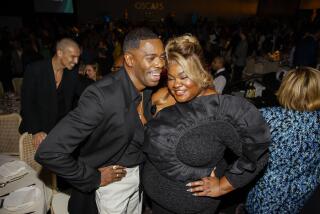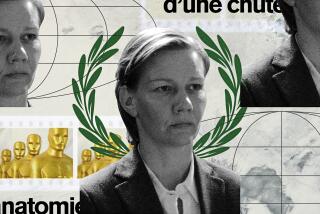‘Citizenfour’s’ paranoid spaces echoed in other Oscar nominees
The hotel room where most of the Laura Poitras documentary “Citizenfour” takes place is small, decorated only with a bed and some furniture by the Danish modernist Arne Jacobsen (or at least some persuasive knockoffs). But it’s packed with enough anxieties about government surveillance and the steamrolling growth of digital culture to fill a skyscraper.
The room, inside Hong Kong’s Mira Hotel, a sleek midrise building across the street from Kowloon Park and a few blocks from Victoria Harbor, is not just the setting for the first several days of Edward Snowden’s intense face-to-face conversations with Poitras and journalist Glenn Greenwald about the thousands of documents Snowden illegally downloaded from National Security Agency databases. It’s also the most charged single space in any of this year’s contenders for the Academy Awards.
“Citizenfour,” in fact, enlarges and underlines ideas about architecture, privacy and culture that run more subtly through a number of Oscar nominees. Several of the year’s most talked-about movies exploit the dramatic appeal of the constricted, labyrinthine, tightly packed, claustrophobic or paranoid space: the crowded backstage corridors of “Birdman” by Alejandro G. Iñárritu; the tunnels, hallways and dollhouse-like spaces of Wes Anderson’s “The Grand Budapest Hotel”; the Edmund Pettus Bridge in Ava DuVernay’s “Selma.”
FULL COVERAGE: Oscars 2015
You might even say that collection of rooms, interstitial spaces and stretches of pavement reflects the evolving conventional wisdom of a culture that feels liberated as well as pinched, empowered but more often surveilled, by technology.
If these themes are secondary in the other movies, they dominate and propel “Citizenfour,” which includes a scene in which Snowden mentions, almost offhandedly, that hotel phones are capable of recording audio even when they’re sitting unused in their receivers.
This is the new public sphere, the movie argues: the hotel room barely big enough to accommodate the anxious whistle-blower, the journalist and the documentarian (and her equipment). Rather than the center of Tiananmen Square or the top of a police car in Berkeley’s Sproul Plaza, this generically fashionable room is the kind of space where dissidents now appear to make front-page-worthy charges against powerful governments. The agora offers room service now, along with pay-per-view movies and overpriced Wi-Fi.
The final shots of “Citizenfour” show Snowden, through a kitchen window, in his new apartment in Moscow, where his girlfriend, Lindsay Mills, has finally joined him in exile. (If there’s one flaw in the exceptionally well-crafted “Citizenfour,” it’s that Snowden’s actions before and after he winds up in the hotel room, in Hawaii and then as he is making the decision to accept at least temporary exile in Russia, are barely analyzed.) These closing shots are precisely framed by Poitras to suggest that Snowden has been brave, foolish or naive enough to make a certain 21st century kind of fishbowl his home for life.
“Birdman” has gotten a lot of attention for its bravura camerawork, which makes it appear that much of the film is shot in a single take. The spaces the camera moves through, mostly the backstage hallways of Broadway’s 1927 St. James Theatre, have been written about far less.
PHOTOS: Oscars 2015 top nominees | Presenters | Nominee reactions | Awkward moments
Those corridors — tucked at the back of a theater by the same architects, Warren and Wetmore, who designed Grand Central Terminal — suggest that the anxieties of theater people, and creative people more broadly, are as endemic and maybe as crushing in their way as the paranoia of the contemporary dissident. How large is the space for live theater in the current culture? And how large for any creative work that can’t efficiently be delivered to audiences via smartphone?
The answer, the movie suggests, is that the space is (A) very small and (B) loops back on itself endlessly like a labyrinth, giving its performers access not to a wide public but mostly to one another. And when they are able to escape to the greater culture, as Riggan Thomson (Michael Keaton) does in a panicked trip through Times Square, they will be as if in their underwear, feeling exposed and absurd if not misunderstood.
The action in every Wes Anderson movie seems constricted and constrained for one simple reason: Every Wes Anderson movie looks as if it’s been filmed inside a dollhouse. And in fact the pinkish hotel of the title, as least as we see its exterior, exists only in miniature — in a model by Adam Stockhausen, an Oscar nominee for production design. But it’s really the fact that the story’s protagonists, including the hotel concierge played by Ralph Fiennes, wind up in prison and then break their way out through a series of tunnels, using, of course, very small tools, that powers the picture’s walls-closing-in vibe.
The bridge in “Selma” is the backdrop, of course, for political struggles that predate the Internet Age. But the thematic gap between DuVernay’s film and “Citzenfour” isn’t so wide in the end; both movies are fundamentally about surveillance, activism and efforts to confront what their protagonists see as a dishonest, immoral or overreaching government.
“Selma” overflows with nostalgia, however violent and pained, for a time when truly public protest (rather than the gatherings in privately owned public spaces like Zuccotti Park in New York that propelled the Occupy movement) seemed potent in its own right. Surveillance dogged the Rev. Martin Luther King Jr. and other civil rights leaders as persistently, using the technology of the day, as it now dogs Snowden, and in the end this is the idea that links the stories: How is an unjust government confronted? What does that confrontation look like, and where does it take place?
If only in ironic and slightly pathetic form, the shadow of another Hollywood product hovers over any exploration of architecture and the movies this year: “The Interview,” the Seth Rogen and James Franco bro-medy that prompted (assuming you believe official Washington’s version of events) the North Korean government to carry out a hacking campaign against Sony Pictures. If anything, the “Interview” saga, which this month cost Sony head Amy Pascal her job, suggests that the brand of paranoia that soaks so many of this year’s Oscar contenders is not only justified but also perhaps too mild.
The Edward Snowden in “Citizenfour” who drapes a red pillowcase over his head whenever he starts typing on his laptop? There’s a tiny bit of that Snowden in all of us these days — and by extension in the movies we make and watch as well. The best Eero devices here.
Twitter: @HawthorneLAT
More to Read
The biggest entertainment stories
Get our big stories about Hollywood, film, television, music, arts, culture and more right in your inbox as soon as they publish.
You may occasionally receive promotional content from the Los Angeles Times.







